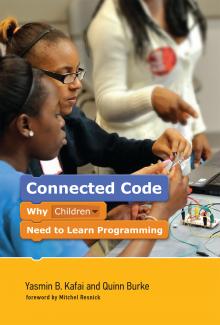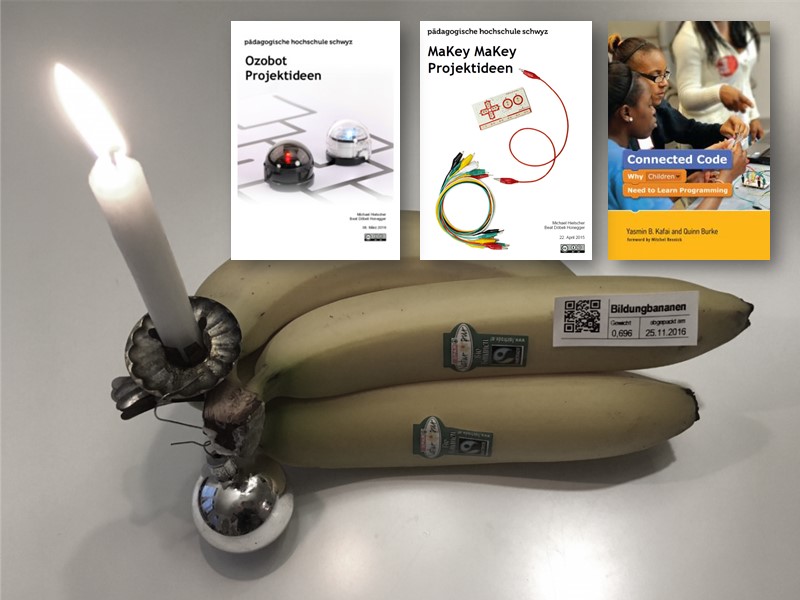 Empfehlungen
Empfehlungen
 In Connected Code, Yasmin Kafai and Quinn Burke update the vision of Seymour Papert’s Mindstorms for today’s world of social media, maker spaces, and the ongoing ‘digital divide.’ The authors show how the goals of Seymour Papert and John Dewey can be realized in the context of today’s technologies, while pointing out who is not yet privileged to participate in modern media. Both a history of ‘code’ in education and a call to action, Kafai and Burke’s book shows us the best of making computing work for student learning—and where we are still falling short. I recommend it to teachers and researchers alike.
In Connected Code, Yasmin Kafai and Quinn Burke update the vision of Seymour Papert’s Mindstorms for today’s world of social media, maker spaces, and the ongoing ‘digital divide.’ The authors show how the goals of Seymour Papert and John Dewey can be realized in the context of today’s technologies, while pointing out who is not yet privileged to participate in modern media. Both a history of ‘code’ in education and a call to action, Kafai and Burke’s book shows us the best of making computing work for student learning—and where we are still falling short. I recommend it to teachers and researchers alike. Zusammenfassungen
Zusammenfassungen
 In this book, we argue that computational thinking needs to be thought of as computational participation because the Computer programs that are being created, used, repurposed, and shared have become our social connections. This view of code as connected has implications for how programming is learned, what is being designed, and where and how it is being shared.
In this book, we argue that computational thinking needs to be thought of as computational participation because the Computer programs that are being created, used, repurposed, and shared have become our social connections. This view of code as connected has implications for how programming is learned, what is being designed, and where and how it is being shared. Die Grundaussage des Buches lautet, dass man computational thinking also das "Denken können wie InformatikerInnen" in der heutigen digital vernetzten Welt weiter denken muss als computational participation. Die beiden Autorinnen sehen bzw. fordern einen Wandel in 4 Dimensionnen:
Die Grundaussage des Buches lautet, dass man computational thinking also das "Denken können wie InformatikerInnen" in der heutigen digital vernetzten Welt weiter denken muss als computational participation. Die beiden Autorinnen sehen bzw. fordern einen Wandel in 4 Dimensionnen:
- Vom Code zur App: Es geht im Informatikunterricht nicht mehr um das erlernen der richtigen und absolut effizientesten Algorithmen sondern um das Erstellen konkreter, nutzbarer Applikationen.
- Vom Werkzeug zur Gemeinschaft: Programmierumgebungen zum Einstieg ins Programmieren gibt es unterdessen wie Sand am Meer. Relevant ist heute eine lebendige Gemeinschaft, die zum Programmieren motiviert und bei Problemen weithilft.
- Vom "Bei 0 anfangen" zum Remixen:Die Industrie macht es vor, in der Schule gilt es noch als Betrügen: Das geschickte Neukombinieren bestehender Elemente.
- Vom Bildschirm zum Begreifbaren: Das Internet der Dinge steht vor der Türe, relevant ist je länger desto mehr nicht mehr das, was auf dem Bildschirm steht, sondern was sich in der Hand halten lässt.
 Coding, once considered an arcane craft practiced by solitary techies, is now recognized by educators and theorists as a crucial skill, even a new literacy, for all children. Programming is often promoted in K-12 schools as a way to encourage “computational thinking”—which has now become the umbrella term for understanding what computer science has to contribute to reasoning and communicating in an ever-increasingly digital world.
Coding, once considered an arcane craft practiced by solitary techies, is now recognized by educators and theorists as a crucial skill, even a new literacy, for all children. Programming is often promoted in K-12 schools as a way to encourage “computational thinking”—which has now become the umbrella term for understanding what computer science has to contribute to reasoning and communicating in an ever-increasingly digital world.
In Connected Code, Yasmin Kafai and Quinn Burke argue that although computational thinking represents an excellent starting point, the broader conception of “computational participation” better captures the twenty-first-century reality. Computational participation moves beyond the individual to focus on wider social networks and a DIY culture of digital “making.”
Kafai and Burke describe contemporary examples of computational participation: students who code not for the sake of coding but to create games, stories, and animations to share; the emergence of youth programming communities; the practices and ethical challenges of remixing (rather than starting from scratch); and the move beyond stationary screens to programmable toys, tools, and textiles.
 The book Connected Code: Why Children Need to Learn Programming (Kafai & Burke, 2014) details this shift from computational thinking to computational participation across four dimensions:
The book Connected Code: Why Children Need to Learn Programming (Kafai & Burke, 2014) details this shift from computational thinking to computational participation across four dimensions:- A shift from code to actual applications: The first question for educators and learners alike is no longer a matter of what programming language is “right” but rather what we ultimately want to make; this is the starting point for creation.
- A shift from tools to communities: There is no shortage of introductory coding tools available, but which ones best facilitate sharing such content? A supportive and resourceful community is, in fact, a tool in and of itself, and developing schools and classrooms around these virtual spaces is an important next step.
- A shift from starting from scratch to remixing: Related to the previous dimension, the question is less about demonstrating prowess by building entirely anew but rather leveraging existing resources (code and otherwise) to improve and reimagine content; what schools perceive as cheating is standard practice in STEM industries.
- A shift from screens to tangibles: The question is no longer what is on your screen but what is in your hands; as evident with the wider inter-net of things, coding and connectivity have migrated away from the traditional vestiges of computers to become truly ubiquitous within the cars we ride and even the clothes we wear.
 In Connected Code, we discuss what children are actually interested in programming, what contexts they do it in, and how they do it. Through the lens of the introductory programming language Scratch, we examine these connections between children and Computer programming along several dimensions:
In Connected Code, we discuss what children are actually interested in programming, what contexts they do it in, and how they do it. Through the lens of the introductory programming language Scratch, we examine these connections between children and Computer programming along several dimensions: - From code to applications, illustrating how students increasingly learn programming not as an abstract discipline but as a way to make actual applica- tions, such as video games and digital stories;
- From tools to communities, highlighting the shift from learning code as an individualistic endeavor to leaming it as a social enterprise;
- From scratch to remix, pointing to the growing possibilities and ethical challenges that are associated with repurposing code as a starting point (or from scratch) for programs; and
- From screens to tangibles, showcasing how coding and computing have moved beyond stationary screens, reintroduced a tangible dimension to digital media, and allowed users to immerse themselves in the physical world through programmable toys, tools, and textiles.
 Bemerkungen zu diesem Buch
Bemerkungen zu diesem Buch
 Bezüglich "Medien und Informatik" (Lehrplan 21): Relevantes Buch zur Bedeutung und Ausrichtung des Informatikunterrichts. Pflichtlektüre für Dozierende in der Aus- und Weiterbildung von "Medien und Informatik", empfohlene Hintergrundliteratur für Lehrpersonen, die "Medien und Informatik" unterrichten.
Bezüglich "Medien und Informatik" (Lehrplan 21): Relevantes Buch zur Bedeutung und Ausrichtung des Informatikunterrichts. Pflichtlektüre für Dozierende in der Aus- und Weiterbildung von "Medien und Informatik", empfohlene Hintergrundliteratur für Lehrpersonen, die "Medien und Informatik" unterrichten. Kapitel
Kapitel 
- 5. From Scratch to Remix
- 7. From Screens to Tangibles
- 7. Connected Teaching
- 8. Coding for All
- 1. The Comeback of Coding (Seite 1 - 18)

- 2. Connected Learning (Seite 19 - 29)

- 3. From Code to Applications (Seite 32 - 49)

- 4. From Tools to Communities (Seite 51 - 72)

 Dieses Buch erwähnt ...
Dieses Buch erwähnt ...
 Personen KB IB clear | Chris Anderson , Sonja Baumer , Yochai Benkler , Matteo Bittanti , danah boyd , John Seely Brown , Amy Bruckman , Leo Burd , Robbin N. Chapman , Katie Clinton , Rachel Cody , Allan Collins , Larry Cuban , Tom DeMarco , John Dewey , Andrea diSessa , P. Duguid , Allan Fisher , Jerry Lee Ford , J. P. Gee , Neil Gershenfeld , Adele Goldberg , Richard Halverson , Idit Harel , Becky Herr-Stephenson , E. von Hippel , Heather Horst , Mizuko Ito , Henry Jenkins , Yasmin B. Kafai , Alan Kay , Caitlin Kelleher , Patricia G. Lange , Jean Lave , Timothy Lister , Dilan Mahendran , John Maloney , Jane Margolis , Sylvia Libow Martinez , Katynka Z. Martínez , Nicholas Negroponte , Tim O'Reilly , David B. Palumbo , Seymour Papert , C.J. Pascoe , Randy Pausch , Kylie A. Peppler , Dan Perkel , Marc Prensky , Ravi Purushotma , Mitchel Resnick , Laura Robinson , Alice J. Robison , Douglas Rushkoff , Natalie Rusk , Carl Sagan , Donald A. Schön , Clay Shirky , Brian Silverman , Herbert Simon , Christo Sims , Gary Stager , Lisa Tripp , Sherry Turkle , David Tyack , Margaret Weigel , Etienne Wenger , Jeannette M. Wing | |||||||||||||||||||||||||||||||||||||||||||||||||||||||||||||||||||||||||||||||||||||||||||||||||||||||||||||||||||||||||||||||||||||||||||||||||||||||||||||||||||||||||||||||||||||||||||||||||||||||||||||||||||||||||||||||||||||||||||||||||||||||||||||||||||||||||||||||||||||||||||||||||||||||||||||||||||||||||||||||||||||||||||||||||||||||||||||||||||||||||||||||||
 Fragen KB IB clear | Gehört Programmieren zur Allgemeinbildung?Should programming be part of general education? | |||||||||||||||||||||||||||||||||||||||||||||||||||||||||||||||||||||||||||||||||||||||||||||||||||||||||||||||||||||||||||||||||||||||||||||||||||||||||||||||||||||||||||||||||||||||||||||||||||||||||||||||||||||||||||||||||||||||||||||||||||||||||||||||||||||||||||||||||||||||||||||||||||||||||||||||||||||||||||||||||||||||||||||||||||||||||||||||||||||||||||||||||
 Aussagen KB IB clear | Creativity Design Principle 02: Low threshold, high ceiling, and wide walls
Lernen ist ein sozialer Prozesslearning is a social process Problemlöseargument: Informatikkenntnisse helfen auch beim Lösen von Problemen ausserhalb der Informatikproblem solving argument: knowledge in computer science fosters problem solving | |||||||||||||||||||||||||||||||||||||||||||||||||||||||||||||||||||||||||||||||||||||||||||||||||||||||||||||||||||||||||||||||||||||||||||||||||||||||||||||||||||||||||||||||||||||||||||||||||||||||||||||||||||||||||||||||||||||||||||||||||||||||||||||||||||||||||||||||||||||||||||||||||||||||||||||||||||||||||||||||||||||||||||||||||||||||||||||||||||||||||||||||||
 Begriffe KB IB clear | AgentSheets
, AkkommodationAccommodation
, Alice.org
, Assimilationassimilation
, BASIC (Programmiersprache)BASIC (programming language)
, CommunityCommunity
, computational participation
, computational thinkingcomputational thinking
,  Computer Computer computer
, computer
,  computer science unplugged computer science unplugged computer science unplugged
, computer science unplugged
,  Computerspiele Computerspiele computer game
, creative coding
, computer game
, creative coding
,  Denken Denken thinking
, thinking
,  design thinking
, design thinking
,  Digitalisierung
, Do It Yourself (DIY)Do It Yourself
, high ceiling
, Informatikcomputer science
, Digitalisierung
, Do It Yourself (DIY)Do It Yourself
, high ceiling
, Informatikcomputer science
,  Kinder Kinder children
, Konstruktionismusconstructionism
, children
, Konstruktionismusconstructionism
,  Lernen Lernen learning
, learning
,  LOGO (Programmiersprache) LOGO (Programmiersprache) LOGO (programming language)
, low floor
, microworldmicroworld
, OOPobject oriented programming
, Open SourceOpen Source
, LOGO (programming language)
, low floor
, microworldmicroworld
, OOPobject oriented programming
, Open SourceOpen Source
,  pair programming
, Pascal (Programmiersprache)
, pair programming
, Pascal (Programmiersprache)
,  Problemlösefähigkeit Problemlösefähigkeit problem solving skills
, problem solving skills
,  Programmieren Programmieren programming
, Programmierkonzepteprogramming concepts
, Rekursionrecursion
, Schreibenwriting
, programming
, Programmierkonzepteprogramming concepts
, Rekursionrecursion
, Schreibenwriting
,  Scratch
, Scratch
,  Spiel Spiel game
, game
,  Sprache Sprache language
, StarLogo
, storytellingstorytelling
, wide walls language
, StarLogo
, storytellingstorytelling
, wide walls
| |||||||||||||||||||||||||||||||||||||||||||||||||||||||||||||||||||||||||||||||||||||||||||||||||||||||||||||||||||||||||||||||||||||||||||||||||||||||||||||||||||||||||||||||||||||||||||||||||||||||||||||||||||||||||||||||||||||||||||||||||||||||||||||||||||||||||||||||||||||||||||||||||||||||||||||||||||||||||||||||||||||||||||||||||||||||||||||||||||||||||||||||||
 Bücher |
| |||||||||||||||||||||||||||||||||||||||||||||||||||||||||||||||||||||||||||||||||||||||||||||||||||||||||||||||||||||||||||||||||||||||||||||||||||||||||||||||||||||||||||||||||||||||||||||||||||||||||||||||||||||||||||||||||||||||||||||||||||||||||||||||||||||||||||||||||||||||||||||||||||||||||||||||||||||||||||||||||||||||||||||||||||||||||||||||||||||||||||||||||
 Texte |
|



























 17
17 









 , 95 kByte)
, 95 kByte) 
 Bibliographisches
Bibliographisches 



 Biblionetz-History
Biblionetz-History